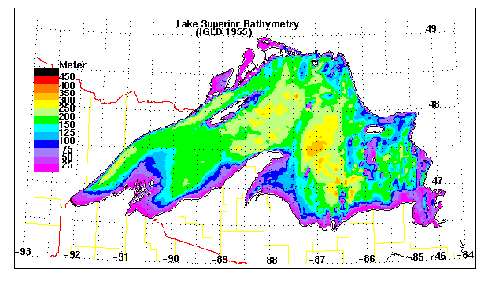Lake Superior – the S in HOMES
The acronym HOMES helps us remember the names of the five Great Lakes. This article focuses on the S in HOMES—Lake Superior.
Lake Superior is the largest of the Great Lakes, both in terms of surface area (31,700 square miles) and volume (2,935 cubic miles), and it has the largest surface area of any freshwater lake in the world! It stretches some 350 miles from east to west and 160 miles north to south, and has a coastline of more than 2,700 miles. Lake Superior holds so much water that all the other Great Lakes – plus an extra three Lake Eries – would be needed to fill its basin! With its average depth  of nearly 500 feet, Lake Superior is also the deepest (1,333 feet) and coldest of the Great Lakes. It takes almost two centuries for the water in Lake Superior to circulate completely through the lake and empty into the St. Marys River, where it will travel through three of the four other Great Lakes – Huron, Erie and Ontario.
of nearly 500 feet, Lake Superior is also the deepest (1,333 feet) and coldest of the Great Lakes. It takes almost two centuries for the water in Lake Superior to circulate completely through the lake and empty into the St. Marys River, where it will travel through three of the four other Great Lakes – Huron, Erie and Ontario.
The basin’s border runs through three states – Minnesota, Wisconsin and Michigan – and Ontario. The basin is sparsely populated, with less than two percent of the Great Lakes basin’s population living there. Lake Superior is rich in natural resources and scenic beauty. It is particularly known for its cold, clean water, rocky shoreline and agate beaches.
 Due to the relatively cold climate and poor soils, the residents of the Lake Superior basin are economically dependent largely on tourism and the basin’s abundant natural resources, which include minerals, metals and forests. The Lake Superior basin is an important region for the production of wood pulp, paper and lumber. Of the 21 northern states, Michigan is the richest in timberland. Minnesota is the largest producer of iron ore in the United States, and mines in the basin supply the nation with 97 percent of its iron ore. In addition to iron ore, Lake Superior ports ship coal, grain, limestone, cement, salt, wood pulp, steel coil, and even wind turbine components. Duluth-Superior, at the western end of Lake Superior, is the busiest inland port in the country and serves nearly 1,000 vessels each year. The main commercial fish species caught in Lake Superior are lake herring, lake trout and whitefish. The recreational fishery is the smallest of the Great Lakes, but still quite active.
Due to the relatively cold climate and poor soils, the residents of the Lake Superior basin are economically dependent largely on tourism and the basin’s abundant natural resources, which include minerals, metals and forests. The Lake Superior basin is an important region for the production of wood pulp, paper and lumber. Of the 21 northern states, Michigan is the richest in timberland. Minnesota is the largest producer of iron ore in the United States, and mines in the basin supply the nation with 97 percent of its iron ore. In addition to iron ore, Lake Superior ports ship coal, grain, limestone, cement, salt, wood pulp, steel coil, and even wind turbine components. Duluth-Superior, at the western end of Lake Superior, is the busiest inland port in the country and serves nearly 1,000 vessels each year. The main commercial fish species caught in Lake Superior are lake herring, lake trout and whitefish. The recreational fishery is the smallest of the Great Lakes, but still quite active.
The Lake Superior basin is unlike the other Great Lakes basins because its terrain is dominated by granite bedrock that is part of the Canadian Shield. This rock dates back to Precambrian times, the oldest era of geological history. The basin is heavily  forested, and conifers dominate the landscape. Because the basin is so sparsely populated, it makes a suitable home for wildlife often not found elsewhere. Wolves and moose live on the mainland and on Isle Royale. Black bear, coyote, Canada lynx, bobcat, beaver, porcupine, white-tailed deer and red fox also live in the basin, along with a variety of birds, amphibians and more than 45 species of fish.
forested, and conifers dominate the landscape. Because the basin is so sparsely populated, it makes a suitable home for wildlife often not found elsewhere. Wolves and moose live on the mainland and on Isle Royale. Black bear, coyote, Canada lynx, bobcat, beaver, porcupine, white-tailed deer and red fox also live in the basin, along with a variety of birds, amphibians and more than 45 species of fish.
Michigan State University Extension and Michigan Sea Grant offer many educational programs to those along Michigan’s Lake Superior shore. We also collaborate with other state Extension programs and regional groups that border Lake Superior, such as the Great Lakes Sea Grant Network, the Great Lakes Observing System, COSEE Great Lakes, the Great Lakes Restoration Initiative, and the Great Lakes Stewardship Initiative, providing additional opportunities to include Lake Erie and those who live in its basin as participants in the Great Lakes Literacy Initiative.
This article was adapted from MSU Extension Bulletin E-1866 (October 2000) – Lake Superior Basin.



 Print
Print Email
Email

